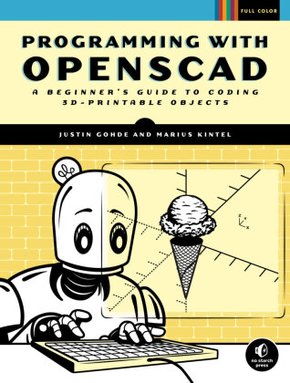Programming with OpenSCAD - A Beginner's Guide to Coding 3D-Printable Objects
| Verlag | No Starch Press |
| Auflage | 2021 |
| Seiten | 206 |
| Format | 17,9 x 1,2 x 23,6 cm |
| Gewicht | 467 g |
| Artikeltyp | Englisches Buch |
| EAN | 9781593279547 |
| Bestell-Nr | 59327954UA |
Programming with OpenSCAD is a STEM-focused, learn-to-code book for beginners that introduces core computational thinking concepts through the design of 3D-printable objects. Develop coding skills as you build increasingly complex 3D models and print them into fun games, puzzles, and more.
OpenSCAD is freely available open source software that enables nondesigners to easily create 3D designs using a text-based programming language. It s a great language for beginners because the instant 3D visualization gives you immediate feedback on the results of your code. This book channels OpenSCAD s visual benefits and user-friendliness into a STEAM-focused, project-based tutorial that teaches the basics of coding, 3D printing, and computational thinking while you develop your spatial reasoning by creating 3D designs with OpenSCAD.
Presuming no prior experience with either programming or 3D design, each chapter builds a scaffolded understanding of core concepts. You ll start by defining, drawing and displaying geometric primitives with text-based code, then expand your creative toolbox with transformation operations like rotating, reflecting, scaling, and combining shapes.
As the projects become more sophisticated, so will your programming skills; you ll use loops for replicating objects, if statements for differentiating your designs, and parameterized, self-contained modules to divide longer scripts into separate files. Along the way, you'll learn 3D printing tips so that you can produce physical mementos of your progress and get physical feedback that lets you correct mistakes in real time. In addition, the book provides hands-on and accessible design exercises at the end of each chapter so that you can practice applying new concepts immediately after they are introduced.
You ll learn:
Programming basics like working with variables, loops, conditional statements, and parameterized modulesTransformation operations, such as rotat e, reflect, and scale, to create complex shapesExtrusion techniques for turning 2D shapes into elaborate 3D designsComputational-thinking concepts, including decomposition, abstraction, and pattern recognition OpenSCAD s Boolean, Minkowski and hull operations for combining multiple 3D shapes into one3D design fundamentals, like navigating the xyz-axis, orthogonal vs. perspective views, and constructive solid geometryOrganizing bigger designs into separate files to make code more readable and collaborative
Accessibly written for a wide audience (advanced middle schoolers, high school students, college students, artists, makers and lifelong-learners alike), this is the perfect guide to becoming proficient at programming in general and 3D modeling in particular.
Inhaltsverzeichnis:
Introduction
Chapter 1: Three-Dimensional Drawing with OpenSCAD
Chapter 2: More Ways to Transform Shapes
Chapter 3: 2D Shapes
Chapter 4: Using Loops and Variables
Chapter 5: Modules
Chapter 6: Flow Control with if Statements
Chapter 7: Design and Engineering
Appendix A: OpenSCAD Language Reference
Appendix B: Visual Command Reference

